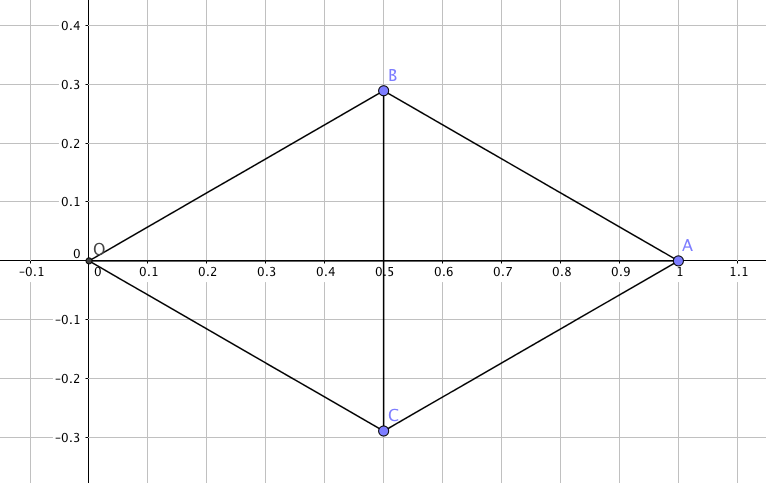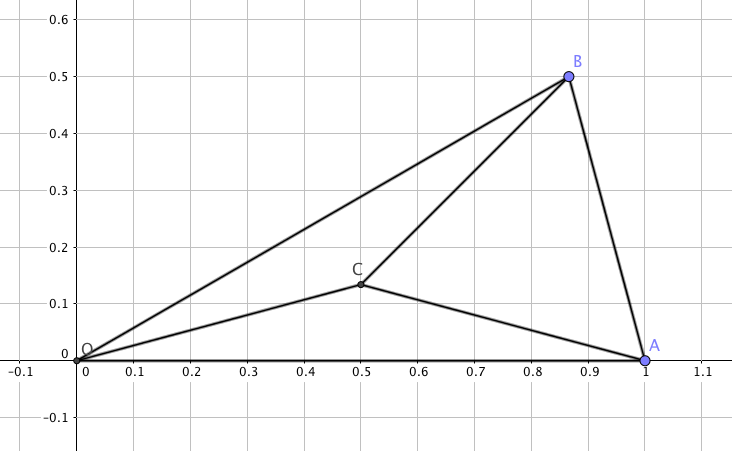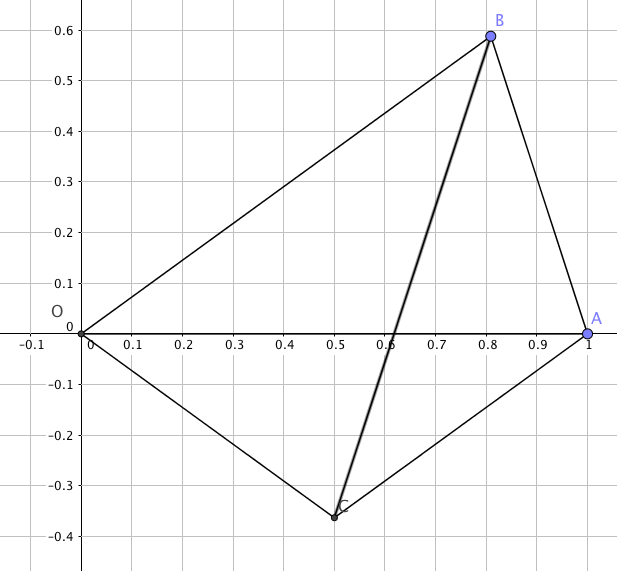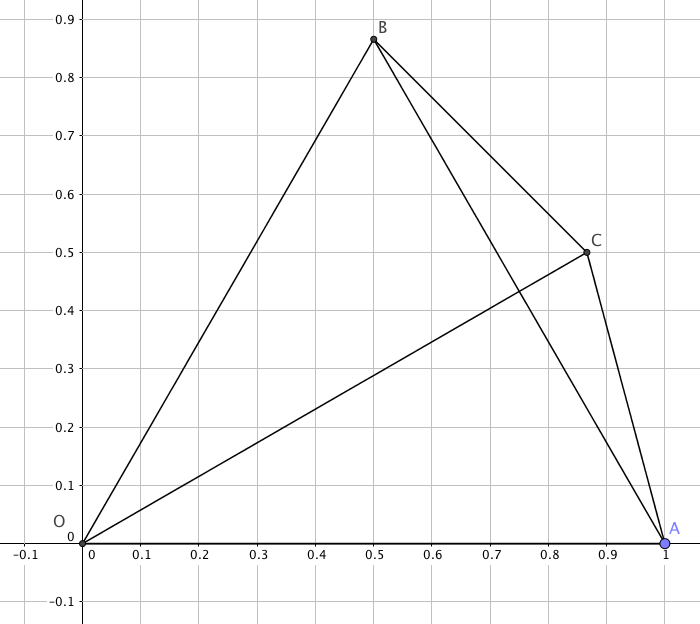Another of Colin's blasted puzzles
Before I begin: this post involves a puzzle and my attempt at a solution; everything above the horizontal rule is spoiler-free, but go beyond that at your peril.
Some days, you can almost hear @colinthemathmo’s chuckle as he innocently poses a question such as:
Find all configurations of 4 points in the plane that define exactly two distances.
and follows up with comments like “are there more solutions?”, “everyone always misses one” and “The challenge now to to convince yourself - and others - that you have them all. But do you … ?!?”
His business card reads “confuser of children and torturer of adults.” But of course it does. He also runs the annual Big MathsJam gathering ((it’s not a conference; it’s not a lecture; it’s more of a confiture)) which has just finished.
Beyond here be spoilers
I attacked this by splitting the possible arrangements of points up into exhaustive cases.
Without loss of generality, let the longest side $OA$ be of unit length, and the remaining points be $B$ and $C$. Note that we need exactly two distances to show up between the points; in any case, it’s impossible for there to be only one, as that would define a tetrahedron.
Case 1): all of the other lengths are $x < 1$.
In particular, $OBAC$ must form a rhombus of side length $x$, and diagonal $BC$ must also have length $x$. Here, $x = \frac{\sqrt{3}}{3}$.

Case 2): four of the other lengths are $x < 1$.
This case splits into two distinct cases: one where (without loss of generality) $OA$ and $OB$ are the unit length sides and one where $OA$ and $BC$ are.
Case 2a): $OA=OB=1$, all other sides have length $x$
Point $B$ must lie on the unit circle centred on $O$, and point $C$ must lie on the perpendicular bisector of $OA$. $CA=CB=CO=AB$, which makes $OAB$ an acute isosceles triangle with $C$ at its circumcentre, forming an equilateral triangle inside. In this case, $x = \frac{\sqrt{2}}{1+\sqrt{3}}$.

Case 2b) $OA=BC=1$, all other sides of length $x$.
$OBAC$ is a rhombus of side length $x$ and equal diagonals, which is a square; $x = \frac{1}{\sqrt{2}}$.

Case 3): three of the other lengths are x < 1.
This case splits into two distinct cases: one where $OAB$ is an equilateral triangle, and one where $OA$, $OB$ and $BC$ are the unit sides.
Case 3a): $OAB$ equilateral.
If $OAB$ is an equilateral triangle, the fourth point is its circumcentre, and $x=\sqrt{3}$.

Case 3b) $OA=OB=BC=1$
(Note: without loss of generality, one of the vertices must abut two of the unit edges; let that point be $O$).
$B$ lies on the unit circle around $O$. $C$ lies on the unit circle around B and on the circle with centre $A$ and radius $AB$. The only configuration that works is a trapezium comprising four points of a regular pentagon; its side length is $x=\phi - 1$.

Case 4): two of the other lengths are $x < 1$.
The two short sides could (in principle) be $AB$ and $AC$ or $AB$ and $OC$. Considering these cases separately:
Case 4a) $AC=BC=x$, $OA=OB=OC=AB=1$.
$OAB$ is an equilateral triangle; $C$ lies on the perpendicular bisector of $AB$, forming a kite. Again, $x = \frac{1}{\sqrt{3}}$.

Interestingly, this is similar to case 2a) in the sense that $O$ is the circumcentre of isosceles triangle $ABC$.
Case 4b) $OC=AB=x$, $OA=OB=AC=BC=1$.
$OACB$ forms a rhombus of side 1. At least one of the diagonals of a rhombus is larger than the side length, so this case is impossible.
Case 5): Only one of the other lengths is $x < 1$.
Without loss of generality, let $OC=x$. $OACB$ is a rhombus with side length 1. As with case 4b), at least one of the diagonals would be larger than 1, so this case is impossible.
Case 0: coincident points
I thought I had finished, but @realityminus3 (always one for thinking outside the box) pointed out there was nothing to stop one of the distances being zero. That adds three further configurations:
- An equilateral triangle with the fourth point added on top of any vertex;
- A line segment with two coincident points at either end;
- A line segment with three coincident points at one end and one at the other.
These feel somewhat like they’re cheating, but there’s nothing in the rules to preclude them.
Conclusion
There are six non-degenerate arrangements of four points in the plane that define exactly two distances:
- a square
- a rhombus comprising two equilateral triangles edge-to-edge
- an equilateral triangle and its circumcentre
- an acute isosceles triangle and its circumcentre
- an obtuse isosceles triangle and its circumcentre
- a trapezium made of four points of a regular pentagon
There are three further solutions if coincident points are allowed:
- An equilateral triangle with the fourth point added on top of any vertex;
- A line segment with two coincident points at either end;
- A line segment with three coincident points at one end and one at the other.
However… for all that I’ve convinced myself there are only nine, I’m open to being told about more!
Colin has also written up a proof which - thankfully! - agrees with mine.